Overview |
|
|
Incident Types |
|
Lab Investigations Incidents |
An Incident is an event. Incidents can be "Planned" or "Unplanned":
| Incident Type | Description |
| Planned | Departure from a nominal process. An amendment is made
to the process to justify the departure prior to execution. Examples:
|
| UnPlanned | Deviation from a nominal process, either automatically
or resulting from another operation. Examples:
|
Planned Incident Life Cycle |
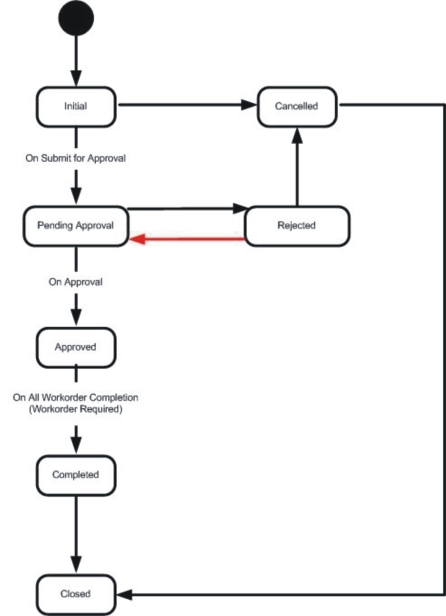
| Status | Description |
| Initial | Incident has been created/recorded. It stays in this state until it is submitted for approval. |
| Pending Approval | Incident has been submitted for approval (after all required modifications). It stays in this state until all approval steps are completed. |
| Rejected | Depending on rules of the Approval Steps, Incident has been rejected. It stays in this state until it is modified and submitted for approval again or cancelled. |
| Approved | Depending on rules of the Approval Steps, Incident is approved. It stays in this state until Workorder is created and completed. |
| Completed | After the Workorder associated with the Incident is complete, the Incident is complete. |
| Cancelled | Incident has been cancelled. |
| Closed | Incident has been closed. No further action is required. |
Unplanned Incident Life Cycle |
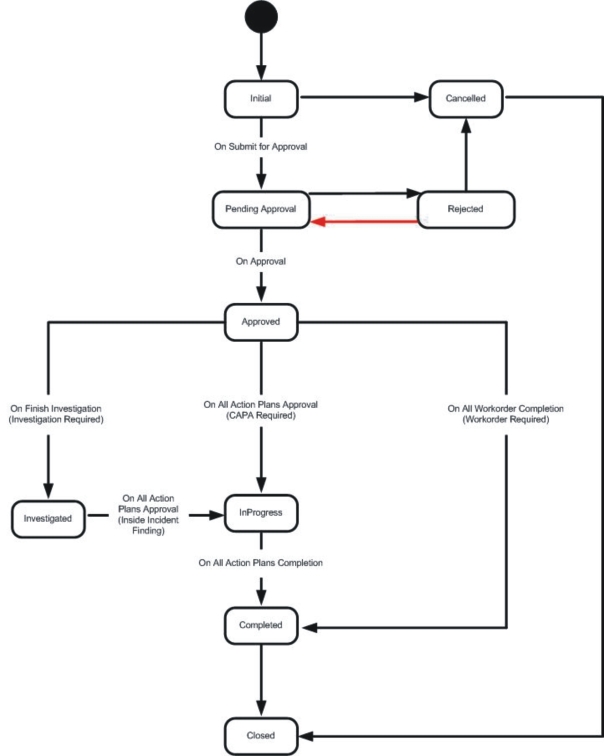
| Status | Description |
| Initial | Incident has been created/recorded. It stays in this state until it is submitted for approval. |
| Pending Approval | Incident has been submitted for approval (after all required modifications). It stays in this state until all approval steps are completed. |
| Rejected | Depending on rules of the Approval Steps, Incident has been rejected. It stays in this state until it is modified and submitted for approval again or cancelled. |
| Approved | Depending on rules of the Approval Steps, Incident is approved. It stays in this state until investigation is carried out or Action Plan is created and approved. |
| Investigated | Incident is under investigation. It stays in this state until Action Plan and/or Workorder is added and completed. |
| InProgress | The Incident's Action Plan and Workorder are added and executed. |
| Completed | After the Action Plan assigned to the Incident is complete, the Incident is complete. |
| Cancelled | Incident has been cancelled. |
| Closed | Incident has been closed. No further action is required. |
Recording Incidents |
|
|
To record a Planned or Unplanned Incident for an SDI selected in a List page, click the "Record Incident" button. A new window opens with a form to record the Incident:

| Field | Description |
| Category | Determines whether the Incident is Planned or Unplanned. |
| Template | Optional Template used to record the Incident. You can also create a template based on the new Incident that is recorded. |
After saving, Incident status is "Initial".
Editing Incidents |
|
|
The Incident Maintenace page (LIMS → Lab Investigations → New Incidents) contains either "Planned" or "Unplanned" detail tabs depending on the Incident type. Other detail tabs are common to both Incident types.
Incident Details: Planned |
This detail is displayed for Planned Incidents:
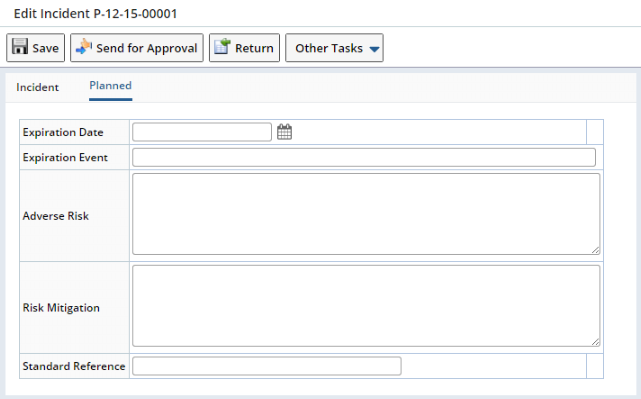
| Field | Description |
| Expiration Date | Expiry date of the Planned Incident. |
| Expiration Event | Event that triggered the Incident expiry. |
| Explanation | Explanation of the Planned Incident. |
| Adverse Risk | Risk associated with the Planned Incident. |
| Risk Mitigation | Steps to mitigate the risk associated with the Planned Incident. |
| Standard Reference | Reference for the Planned Incident. |
Additionally, the specialized "Submit for Approval" button can be used to submit the Incident for Approval (see Approving Incidents).
Incident Details: Unplanned |
This detail is displayed for Unplanned Incidents:
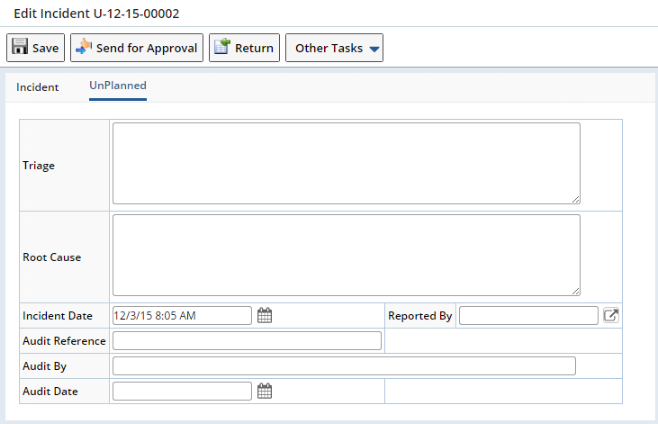
| Field | Description |
| Explanation | Explanation of the Unplanned Incident. |
| Triage | Determine priorities for action taken for the Unplanned Incident. |
| Root Cause | Cause of the Unplanned Incident. |
| Incident Date | Occurrence and recorded date of the Unplanned Incident. |
| Reported By | User records the Unplanned Incident. |
| Audit Reference | Audit reference for the Unplanned Incident. |
| Audit By | User who performs the audit. |
| Audit Date | Date of the audit. |
Additionally, the specialized "Submit for Approval" button can be used to submit the Incident for Approval (see Approving Incidents).
Incident Details: Common |
These details are common to both Planned and Unplanned Incidents.
Incident Detail |
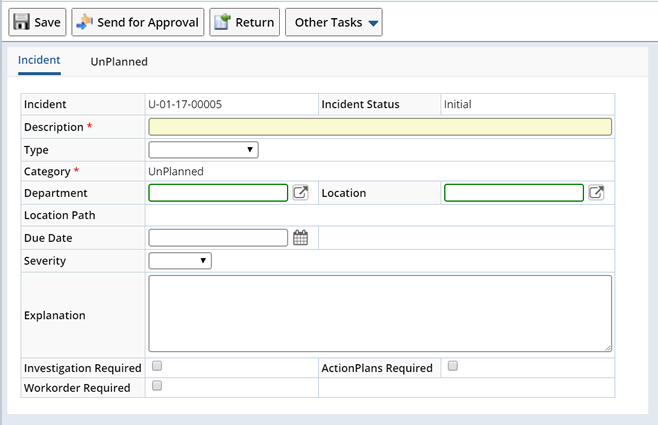
| Property | Description |
| Incident | Automatically generated identifier of the Incident. |
| Incident Status | Status of the Incident. When you create new Incident,
this term depends on the Incident type:
After saving a new Incident, the term becomes "Incident Status". |
| Description | Description of the Incident. |
| Type | Type of Incident (for display purposes only). |
| Department | Department responsible for the Incident. |
| Location | Location where the Incident occurred. |
| Due Date | Date and time the Incident is due for execution. |
| Severity | Severity of the Incident. |
| Investigation Required | Indicates that the Incident requires investigation, allowing optional Investigation of the Incident. Typically used for Unplanned Incidents. |
| ActionPlans Required | Indicates that Actions Plans are used for Incident. Alternatively, you can simply track the opening and closure of Incidents. Typically used for Unplanned Incidents. |
| Workorder Required | Typically, tasks are assigned to execute Action Plans.
This allows tasks to be added through a Workorder. It also allows tasks
to be assigned (through Workorder) to the Incident itself.
Used for both Unplanned and Planned Incidents. |
Attachments |
This lets you access the Attachment Manager (see Attachments for the latest functionality).
Approvals |
The "Approvals" tab provides an SDI Approval detail (see Approval Using the sdidetailmaint Element). "Approval" in this context is the process of accepting an Incident after it has been recorded and (if required) edited.
You can add an Approval Type from here. Alternatively, while recording a new Incident, if you use a Template that is associated with an Approval Type, the Approval Type is automatically added to the Incident.
The choices here are:
Note that if you do not add any Approval Types to the Incident, clicking the "Send for Approval" button transfers the Incident directly to the "Active Incident List" page under "Incidents" with a status of "Approved".
If a Sample or Study has Incidents, an icon shows this in the relevant List page.

Incident Items |
This shows the SDC and SDI keys affected by the Incident.

Approving Incidents |
|
|
Submitting for Approval |
You can submit an Incident for Approval while editing an Incident (see Editing Incidents). In this case, the Incident transitions to the "Incidents for Approval" menu with a status of "Pending Approval".
Alternatively, you can edit a previously recorded Incident from the Lab Investigations → New Incident tramstop by clicking the "Edit" button. This also opens the Incident Maintenance Page used for editing Incidents.

In the Incident Maintenance page, click the "Send for Approval" button when you are certain that the information is correct and requires no further modification.
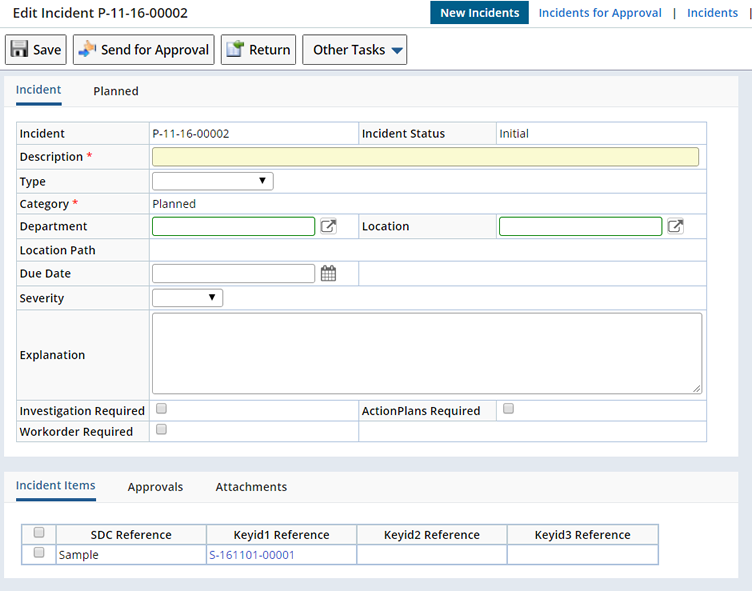
If you do not add any Approval Types to the Incident, then click the "Send For Approval" button, the Incident transitions directly to the "Active Incident List" page (Lab Investigations → Incidents tramstop) with a status of "Approved".
If you add Approval Types requiring further Approval, the Incident is then shown on the "Incidents Pending Approvals List" page (Lab Investigations → Incidents for Approval) with a status of "Pending Approval".
Reviewing Approvals |
Review Incidents from the "Incidents Pending Approvals List"page (Lab Investigations → Incidents for Approval), which shows all Incidents with the status as "Pending Approval". Select an Incident, and then click the "Review" button.

In the resulting read-only Maintenance page, the "Incident Item" tab lists SDIs affected by this Incident. To approve or reject a selected Incident, click the "Approve/Reject" button.
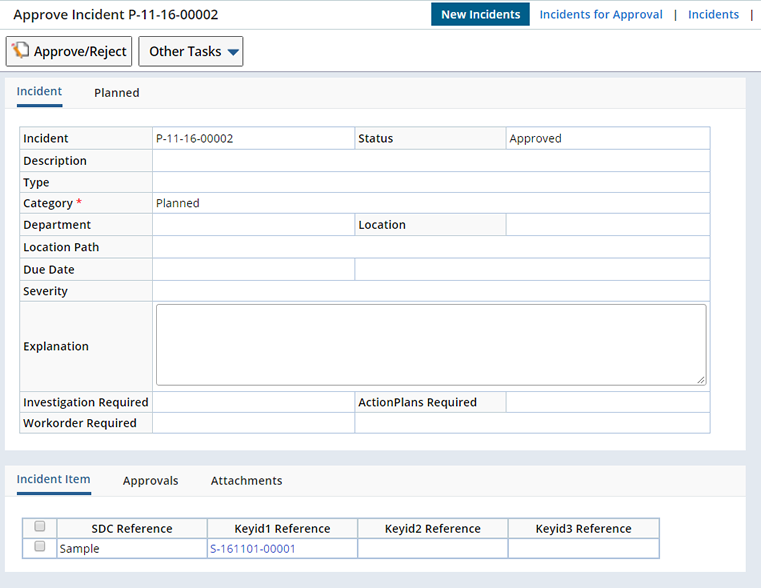
The next page shows Approval Steps for the current User. Select an Approval Step and enter a relevant comment.
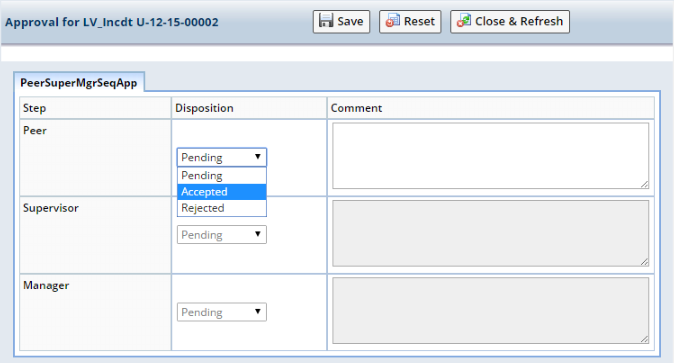
When all mandatory Approvals are complete, click "Save".
The definition of the Approval Type indicates what is required for the approval to pass/fail, and subsequently update the Incident status.
Click "Close & Refresh". The status of the Incident updates in the Maintenance page.
Specialized Operations in the New Incident List Page |
|
|
In addition to standard "Edit" and "Delete" buttons, the New Incident List page provides these specialized operations.
Add Incident |
Use this operation for adding adhoc Incidents. The "Add" button prompts for an Incident Template, then calls the RecordIncident Action. The Action then adds the Incident with only the Template Id as an input.
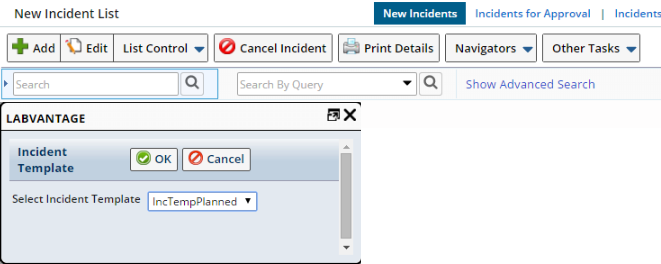
Cancel Incident |
Use this operation to discard a Planned Incident. A "cancelled" Incident is "closed", i.e., you cannot do anything else with it.
To cancel a Planned Incident, select the Lab Investigations → New Incidents tramstop, then select a Planned Incident from the "New Incident List" page and click"Cancel Incident".
Incident status changes to "Cancelled", and the cancelled Incident is displayed on the "Historical Incident List" page.
View Incident Tree |
This shows a hierarchical view of an Incident, Action Plan, Findings and Workorder. You can use a button or link to do this.
Using a button, select the Lab Investigations → New Incidents tramstop, then select an Incident from the "New Incident List" page and click "View Incident Tree".

Alternatively, you can click a hyperlinked Incident from any page that lists Incidents.
In either case, the hierarchy is shown in a new window.
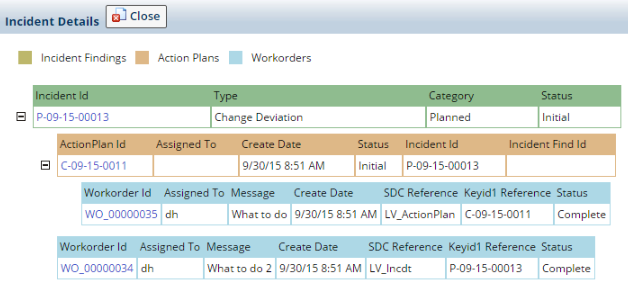
Copy To Template |
Use this operation to create a Template from an Incident. You can then use the Template to create a new Incident.
From the Lab Investigations → New Incidents tramstop, select an Incident from the "New Incident List" page, then click the "Copy to Template" operation on the sidebar.

Create template page gets displayed in a new window.
In the new window that opens, provide a name for the Template. The new Template will be listed in the "New Incident List" page.
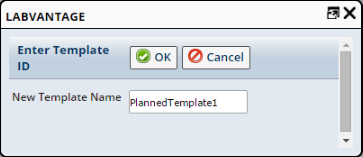
Print Details |
To view an Incident detail report, select an Incident from the New Incident List page, then click the "Print Details" button.
The Incident details report is shown in a new window in PDF format.
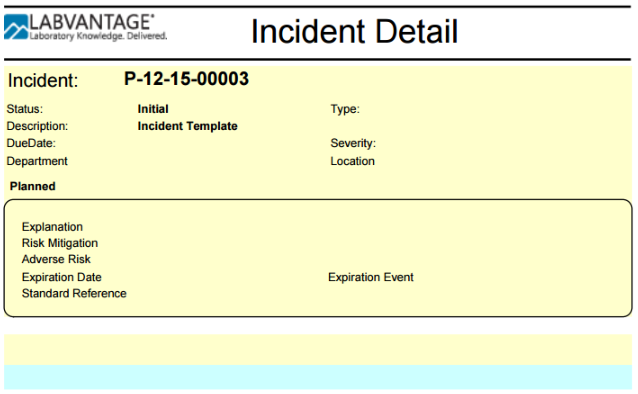
Investigating Incidents |
|
|
Investigations |
If an Incident requires "investigation" (resulting in "findings" of the investigation):
To investigate, select the Lab Investigations → Incidents tramstop, then select an Incident from the "Active Incident List" page and click "Edit/Investigate".

In the Edit Incident page, click "Finish Investigation". Incident status changes to "Investigated".
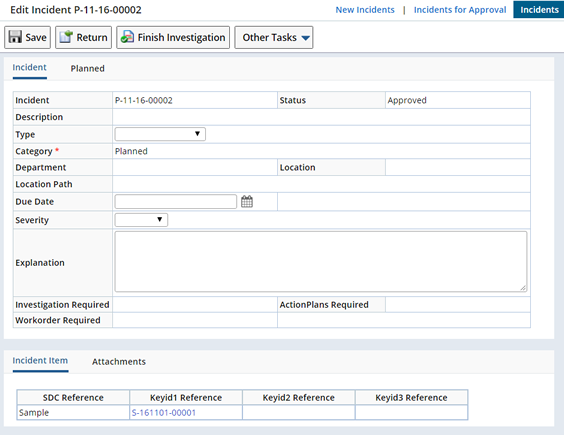
Findings |
As you investigate an Incident, you can record the "findings" (results) of the investigation. Select the Lab Investigations → Incidents tramstop. Select an Incident, then click "Edit/Investigate".
In the "Incident Findings" detail of the Incident Maintenace page, click "Add".

In the next page, provide this information:
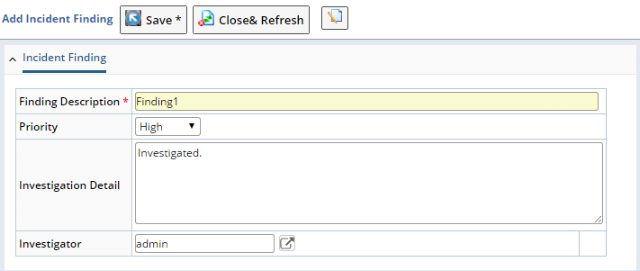
| Property | Description |
| Findings | A brief description of the finding. |
| Priority | Priority of the investigation result. |
| Investigation Detail | Detail description of the investigation carried out. |
| Investigator | Name of the person who carried out the investigation. |
After saving these changes, the "Action Plan" tab is displayed.
Historical Incidents |
|
|
Viewing Historical Incidents |
To view Incidents with status of "Closed", "Cancelled", or "Completed", select the Lab Investigations → Historical Incidents tramstop. These Incidents are shown in the Historical Incident List page.

Closing Incidents |
When all operations have been completed for an Incident (Investigation, Action Plan, and Workorder), you can "close" the Incident. You cannot do anything with a closed Incident. Select the Lab Investigations → Incidents or Lab Investigations → Historical Incidents tramstop. Select an Incident from the list page, then click "Close Incident".
In general, only completed Incidents can be closed (status changes to "Closed"). An exception is that when a Workorder or Investigation are not required for an Incident, an Incident with "Approved" status can be closed from the "Active Incident List" page. Otherwise, Incidents are closed from the "Historical Incident List" page.
Viewing Incident Details |
Use the "View" button on the Historical Incident List page to view read-only Incident details for Incident status of "Closed", "Cancelled", or "Completed".
The view Incident details maintenance page gets displayed in a new window.